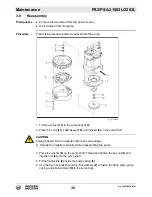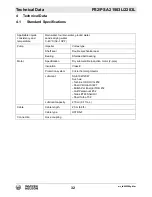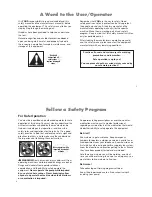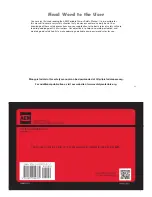
Pumps in General
Safe Working Procedures
USE COMMON SENSE!
Most accidents can be
avoided by using common sense and concentrating
on the job to be done.
Only Experienced and Qualified Personnel
should
install and operate pump equipment.
KNOW THE PROPER starting procedure for your
equipment. Follow the manufacturer’s operation
manual(s) ... to the letter.
DO NOT operate a pump
without all guards and
shields in place. (If OSHA required guards are damaged
or misplaced, contact the manufacturer for a
replacement.)
When
lifting pump
use only lifting equipment in
good repair and with adequate capacity. Follow
manufacturer’s lifting recommendation.
Check all lubricant levels
before pump installation in
accordance with manufacturer’s maintenance programs.
Keep hands and feet clear
of moving parts. DO
NOT stick fingers into a pump when in operation.
Check suction strainer and hose regularly for proper
submergence and to be sure it is free of obstructions.
NEVER operate
a self-priming pump unless the volute
is filled with liquid. The pump will not prime when dry.
PUMP only liquids
for which the pump has been
designed to handle. Verify the hoses and piping have
the correct pressure rating for the application.
DO NOT
pump flammable, corrosive, hazardous,
volatile or caustic materials unless the pump and piping
are explicitly designed for that purpose.
NOTE the direction of rotation
— operation of a
pump in the wrong direction can cause the impeller
to unscrew and damage the volute case.
A pump should not be operated against a closed
valve or other no flow conditions.
Refer to the pump
manufacturer’s recommended practice for start-up,
operation and shut-down procedures.
DO NOT
close
down or restrict a discharge hose.
Be careful
of
discharge hose whipping under pressure.
Operate Safely
17
MAKE CERTAIN
that whatever is to be connected to
the pump is not subjected to pressures greater than
those given in the manufacturer’s instructions.
MAKE CERTAIN all connections are securely
made and hoses under pressure are secured, with
appropriate safety devices, to prevent whipping.
BE AWARE OF LIGHTNING.
Stay clear of the pumping
equipment during electrical storms. It can attract
lightning.
Not for use with potable water
unless otherwise
stated by the manufacturer.
Overheating Precautions
Overheated pumps can cause severe damage
to the
equipment and can cause severe physical burns and
injury.
Operating a pump with the suction and/or discharge
valve closed
is a principal cause of overheating.
Approach cautiously any pump that has been in
operation.
DO NOT remove hoses
from a pump until the system
is properly cooled to ambient temperature.
DO NOT remove the cover plate
or drain plugs from
any overheated pump. Allow the pump to cool. Check
pump temperature before opening fill port or drain plug.
If overheating of the pump casing occurs:
• STOP the pump immediately
• Allow the Equipment to cool completely
• Slowly and cautiously vent the pump
• Refer to the manufacturer’s instruction manual before
restarting the unit
• Remove hoses carefully. Heated water can be in
hoses and static head produces pressure
Stay clear of pump
during electrical
storms
Operate Safely
18
Содержание PS2 1503L
Страница 23: ...wc_tx001296gb fm 23 PS2 PSA2 1503L 2203L Operation wc_gr007336 1 2 3 4 5...
Страница 54: ......
Страница 56: ......














































